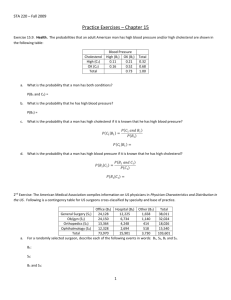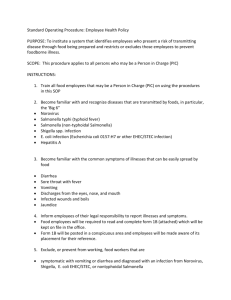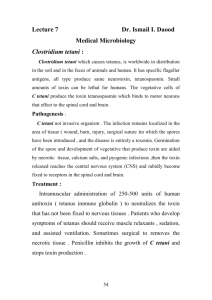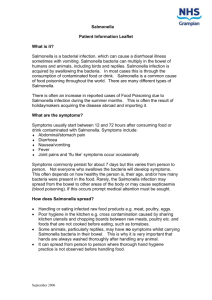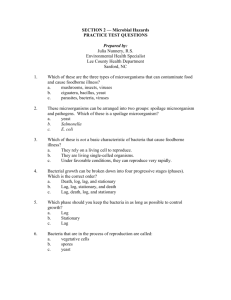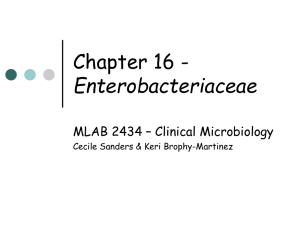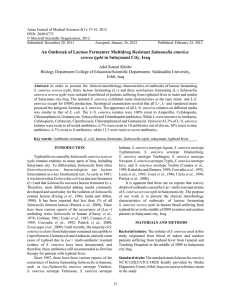GRAMNEGATIVE ENTERIC RODS
advertisement
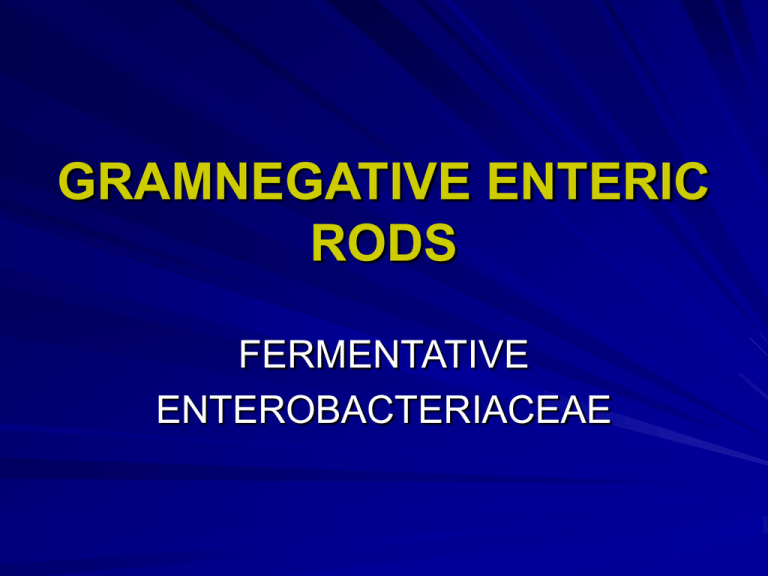
GRAMNEGATIVE ENTERIC RODS FERMENTATIVE ENTEROBACTERIACEAE G- bacteria G- rods Family: ENTEROBACTERIACEAE Largest and most heterogenous collection of medically important G- bacilli 32 genera, over 130 species Classification based on: - biochemical properties - antigenic structure - nucleic acid hybridization and sequencing Less than 20 species responsible for over 95% of infections Enterobacteriaceae Ubiquitous organisms found worldwide in - soil - water -vegetation Some of them are part of normal intestinal flora of most animals Cause variety of human diseases: - up to 35% of all septicaemias - over 70% of urinary tract infections - diarrheas Some organisms are strict patogens: Shigella, Salmonella typhi, Yersinia pestis (always associated with disease) Members of normal intestinal flora able to cause opportunistic infections: Escherichia coli, Proteus mirabilis, Klebsiella pneumoniae Normally commensal flora becoming pathogenic after acquiring virulence factor genes on plasmids, bacteriophages or pathogenicity islands: E.coli associated with gastroenteritis COMMON MEDICALLY IMPORTANT ENTEROBACTERIACEAE: Citrobacter fruendii, C. buseri, Enterobacter cloaceae, Enterobacter aerogenes, Escherichia coli, Klebsiella pneumoniae, Klebsiella oxytoca,Morganella morganii, Proteus vulgaris, Proteus mirabilis, Serratia marcescens, Shigella flexneri, Shigella sonnei, Salmonella typhi, Salmonella enterica,Yersinia pestis, Yersinia enterocolitica, Y.pseudotuberculosis Enterobacteriaceae infections can originate from animal reservoir: most Salmonella and Yersinia species human carrier: Salmonella typhi and Shigella species through endogenous spread of organisms in a susceptible patient Structure and Physiology Gram-negative bacilli Size: 0.3 – 1.0 x 1.0 – 6.0 mm Do not form spores (non-sporogenous) Motile (with peritrichous flagella) / non-motile Fast aerobic or anaerobic growth (facultative anaerobes) on variety of nonselective and selective media Ferment glucose, reduce nitrate, catalase+, oxidase- (absence of cytochromeoxidase) Structure and Physiology – cont´d Lactose fermenting strains (Endo Agar): Escherichia, Klebsiella, Citrobacter, Serratia and Enterobacter Resistant to bile-salts: Salmonella, Shigella Some have prominent capsules (Klebsiella) Others surrounded by a diffusible slime layer Antigens: somatic O polysaccharide + lipid A (endotoxin) flagellar H proteins (heat-labile) capsular K proteins or polysaccharides (heat-labile) Antigenic structure Pathogenesis and Immunity FACTORS OF VIRULENCE: Endotoxin Capsule Antigenic Phase Variation Type III Secretion Systems Sequestration of Growth Factors Resistance to Serum Killing Antimicrobial resistance Endotoxin Activity based on Lipid A released at cell lysis Activation of complement Release of cytokins Leukocytosis Thrombocytopenia Disseminated intravascular coagulation Fever Decreased peripherial circulation Shock Death Capsule Protects bacteria from phagocytosis by hydrophilic capsular antigens which repel the hydrophobic phagocytic cell structure. These antigens interfere with the binding of antibodies to bacteria and are poor immunogens or complement activators. !!! Development of specific anti-capsullar antbodies Antigenic Phase Variation Protects bacteria from antibody-mediated cell death = genetic control of expression of capsular and flagellar antigens Alternative expression of H and K antigens Type III Secretion Systems Salmonella, Escherichia, Shigella, Yersinia have common effector system for delivering their virulence genes into targeted eukaryotic cells. Type III Secretion System consists of approx. 20 proteins that facilitate secretion of bacterial virulence into the host cell. In the absence of TIIISS the bacteria loose their virulence. Sequestration of Growth Factors Nutritional scavengers of bacteria growing in vivo. Iron – bound in heme proteins (haemoglobin, myoglobin) or in iron-chelating proteins (transferrin, lactoferrin) Bacteria counteract the binding by producing own competitive iron-chelating compounds (siderophore enterobactin) Iron can also be released from host cells by hemolysins produced by bacteria. Resistance to Serum Killing Virulent organisms capable for producing systemic infections are often resistant to serum killing: Bacterial capsule Factors preventing binding of complement components to the bacteria and subsequent complement-mediated clearence Escherichia coli Normal flora of intestine Pathogenic effect depends on E. coli strain ETEC (enterotoxigenic) EPEC (enteropathogenic) EIEC (enteroinvasive) EHEC (enterohemorrhagic) HUS (hemolytic-uremicsyndrome) UTI – have P pilli Meningitis, pneumonia Escherichia coli ETEC – labile and/or stable toxins causes deregulation of intestinal cells and a volumi- nous watery diarrhea (traveller´s diarrhea) EPEC – binds to intestinal cells with bundleforming pilli and causes cupping of intestinal epithelial cells, altered function, diarrhea. EIEC – Shigella-like: bind to and invade M cells – lateral spread to enterocytes. Cause bloody diarrhea. EHEC – bind to enterocytes by BFP, produce shigatoxin (causes bloody diarrhea) HUS – hemolytic uremic syndrom (hamburger disease) Escherichia coli E. coli with K1 capsule – newborn meningitis Pneumonia: aspiration of GIT organisms Urinary tract infections Immunity : strain-specific. Protective antibodies against toxins, pilli, adhesins Epidemiology: contaminated food, carriers, endogenous infections – displacement from GIT Diagnostics: culture+microscopy, lactose +, biochemical properties, serotyping (O,H,K). Salmonella S. typhi S. paratyphi S. typhimurium S. enterica Salmonella typhi Diseases caused: typhoid fever (blood-born infection involving multiple organs, starting as obstipation Carriers of salmonella Salmonella typhi Pathogenesis: Salmonella typhi invades through M cells in the small intestine – transport through lymphatics --- bloodstream --- phagocytosis of organisms – grow in macrophages of the liver, spleen and other organs. Typhoid fever – organisms released from lysed macrophages reseed the bloodstream Carriers harbor bacteria in tissues (gall bladder) and pass microorganisms in the stools Immunity: protective antibodies to O-antigen (LPS), vaccination Salmonella typhi Epidemiology: human-human spread, water contaminated with feces (drinking water) Diagnostics: culture (blood, endo, DC-agar, Wilson-Blair agar, McConkey agar) G- bacilli with flagella Serotyping (O,H,Vi antigens) THERAPY: chloramphenicol PROTECTION: live vaccine (oral) Salmonella enterica causes gastroenteritis Organisms bind to enterocytes by pilli in the small intestine and cause ruffles on the cell surface. Bacteria invade the cells, migrate through the cells into the lamina propria of small intestine causing an intense inflammation. This leads to malabsorption and diarrhea. Disease is usually self-limiting in healthy people Salmonella enterica Immunity: antibody to LPS O-antigen can be protective, but protection is strain-specific Epidemiology: Common pathogenic strains are acquired by food contaminated with feaces from infected animals or humans. Most animal sources: eggs and poultry. More than 1500 different serotypes can cause diarrhea in humans Most frequent: Salmonella enterica serotype enteritidis Salmonella enterica Diagnostics: stool samples plated solid medium ----------------------(Blood, Endo, DC-agar McConkey) Microscopy: G- rods Serotyping: O and H antigens Biochemical characterisation (API, Enterotest) Shigella S. dysenteriae S. flexneri S. sonnei Causes dysentery : frequent, low-volume stools containing inflammatory cells and blood 30 or more portions a day HIGHLY INFECTIVE!!!! 10 bacteria initiate disease Shigella Pathogenesis: Descending infection from small intestine to large intestine (main site). Organisms bind to M cells and invade lamina propria, then invade neighboring enterocytes from the bottom. Bacteria grow and induce actin polymerization that pushes them laterally into neighboring cells, where continue to spread causing cell-death and inflammation Immunity: little innate protection. Convalescent antibodies to O-antigen (LPS) Shigella Epidemiology: Highly infectious, fecal-oral spread. Human are the only reservoir Diagnosis: culture+microscopy G- rods without flagella, do not grow on WB, serotyping (O antigen) NO VACCINE AVAILABLE Yersinia Y. pestis : Plague – bubonic – potentially fatal - pneumonic – highly contagious, lethal Y. pseudotuberculosis: mesenteric lymphadenitis (pseudoappendicitis) Y. enterocolitica: gastroenteritis, mesenteric lymphadenitis Yersinia pestis Yersinia enterocolitica Yersinia pseudotuberculosis Family: Vibrionaceae Genus: Vibrio Family: Vibrionaceae Vibrio cholerae Disease caused: CHOLERA (voluminous watery diarrhea, life-threat through dehydration Pathogenesis: ingestion of fecally contaminated water or food. Flagellar motility + mucinase – penetration to epithelium of small intestine. Toxincorregulated pilli – attachment, toxin production causes deregulation of crypt-cells by ADPribosylating Gs protein of adenylate cyclase system.Efflux of water + ions into the lumen Vibrio cholerae Vibrio cholerae Immunity: Antibody to cholera toxin greatly reduces the severity. VACCINATION Epidemiology: Virulent organisms – O1 or O139 antigens. O1 serotypes AB (Inaba), AC (Ogama) ABC (Hikojima). 2 biovars: classical and El Tor. Organisms live in salt water attached to algae copepods or shells of crustaceans. If conditions become unfavorable – dormant and unculturable Contamination of water sources - epidemies Vibrio cholerae, serotype O1 and O139 virulence factors Family: Campylobacteriaceae Spiral G- bacteria with Low C-G DNA ratio, inable to ferment or oxidize carbohydrates, with microaerophilic growth requirements, motile Campylobacter C. jejuni, C. ilei Arcobacter Family: unnamed Walinella Helicobacter H. pylori Flexispira Genus: Campylobacter Campylobacter jejuni Helicobacter pylori Helicobacter pylori Pseudomonas aeruginosa Straight or slightly curved G- bacilli, motile (polar flagella), 0.5 to 1.0 x 1.5 – 5.0 mm. Contain cytochromeoxidase Produce different pigments (pyocyanin – blue), fluorescein –yellow and pyorubinred/blue). Main cause of nosocomial infections Pseudomonas aeruginosa


